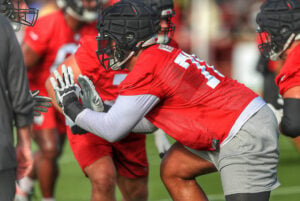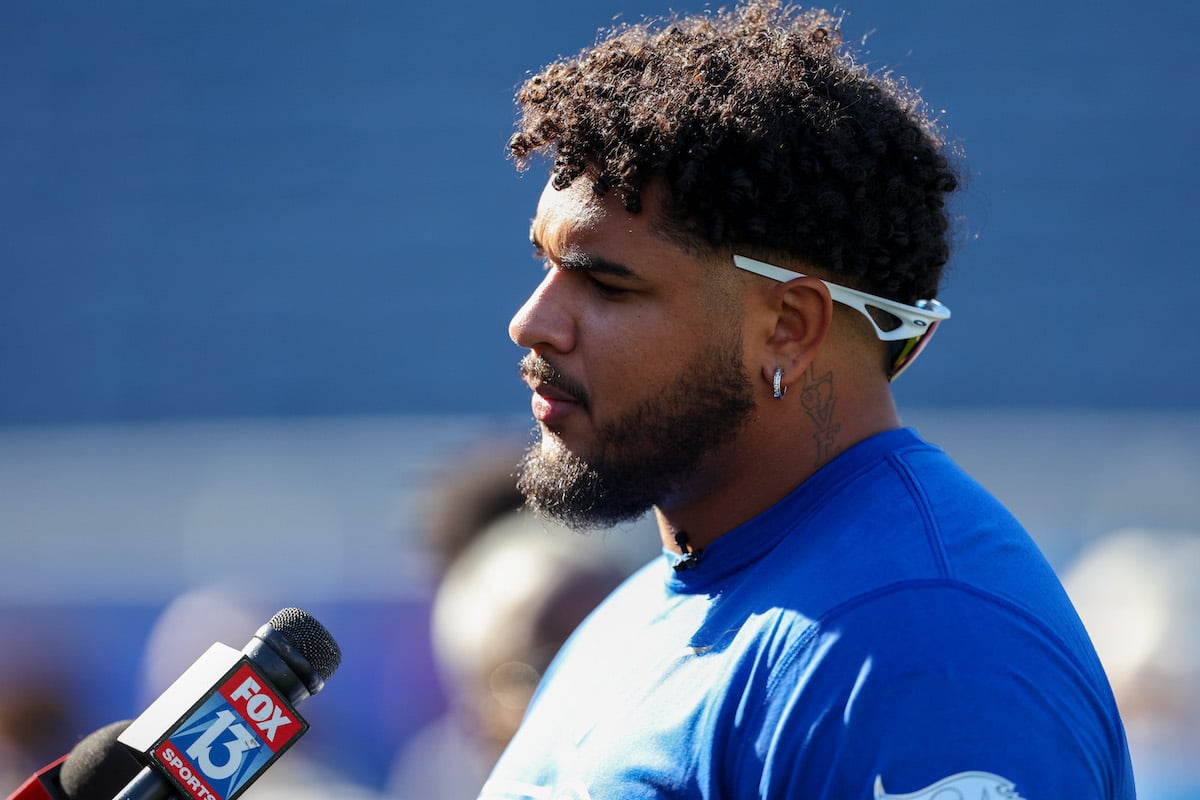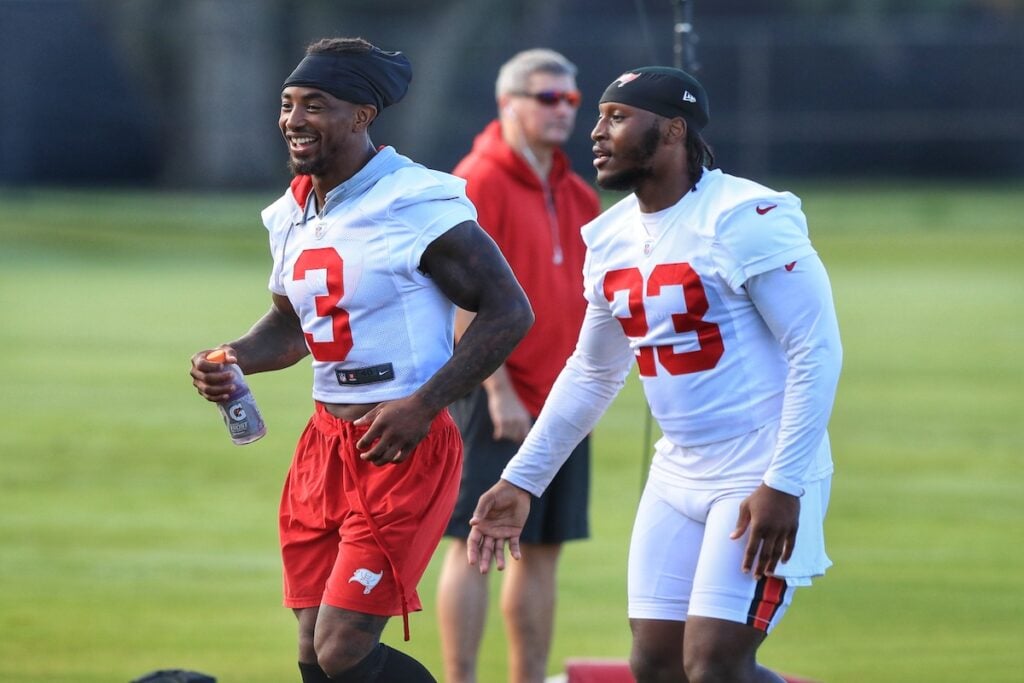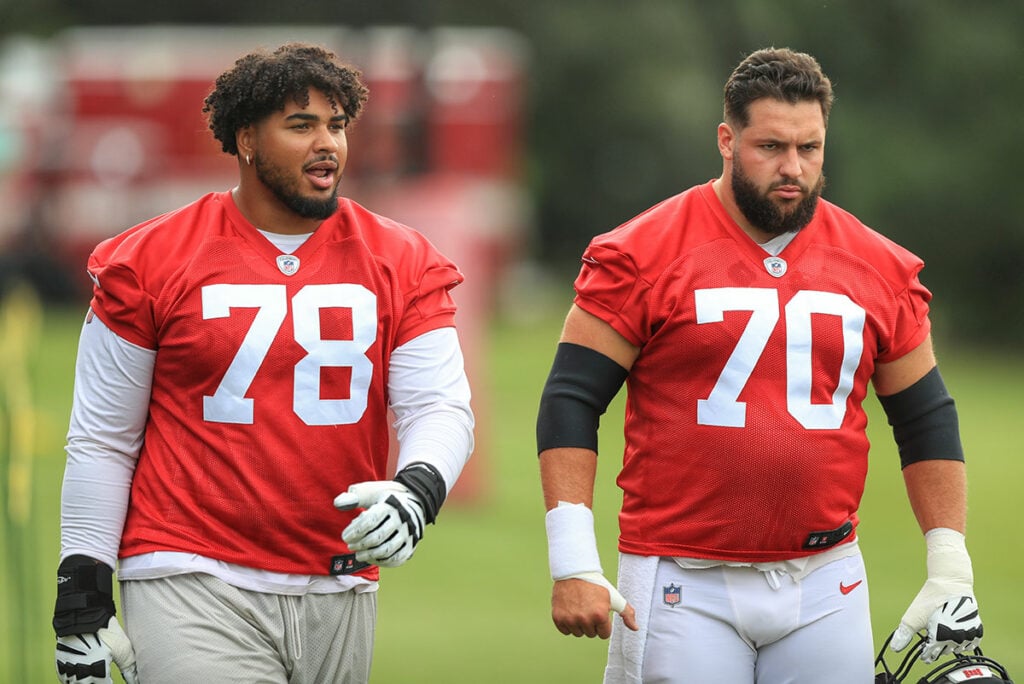Tristan Wirfs’ contract extension is quickly becoming one of the biggest storylines at Bucs training camp. And this is not because of Wirfs or the Bucs themselves.
General manager Jason Licht has said all the right things about the contract needing to right for both player and team and that he is hopeful they will get a deal done soon. Wirfs, for his part, eschewed both a hold-out and a hold-in, instead opting to be a full participant in camp to this point.
Both sides seem to be negotiating in good faith and spirits. This begs the following question. If everyone wants the same thing, why is it taking so long to get an extension over the goal line (pun 100% intended)?
Here are the three possible reasons.
Bucs And Tristan Wirfs May Be Apart On APY (Average Per Year)
This is the most talked about possible reason a deal may not be as imminent as Bucs fans hope. The offensive tackle market got turned on its head this offseason. As of February, the top tackle deal in the NFL belonged to Laremy Tunsil of the Texans. In 2023 he signed an extension worth $25 million per year. Then in April, the Lions jumped the shark with a four-year, $112 million deal with their star right tackle Penei Sewell. It was a full $3 million per year over Tunsil’s deal and was agreed to after Sewell’s third year in the league.
If the Bucs were close to a deal with Tristan Wirfs at that time, I can assure you it blew up with the news of Sewell’s new contract. Since then, two more relevant pieces of information have come out.
First the Vikings have also locked up a premier tackle after his third year when just this week they agreed to a four-year, $104 million deal with left tackle Christian Darrisaw. Additionally, 49ers left tackle Trent Williams is currently holding out of training camp in an effort to improve the six-year, $138.06M deal he signed covering 2021-2026.
Here is the breakdown of Christian Darrisaw’s four year, $104 million contract extension with the #Vikings https://t.co/LOtpLhGqZQ
— Jason_OTC (@Jason_OTC) July 25, 2024

Bucs LT Tristan Wirfs – Photo by: Cliff Welch/PR
If the Bucs were prepared to pay Wirfs $26 million per year before the Sewell deal, Darrisaw’s contract fully blows that out of the water. Wirfs has played more snaps and has been a far superior pass blocker over Darrisaw’s entire career. And while Darrisaw has graded out as a better run blocker this is still a passing league.
But what might the Bucs see as the top value for Wirfs on a per annum basis? My guess is it could be $27.2 million. Here’s why.
If the two sides cannot come to an agreement by the 2025 league year in March it is a foregone conclusion the Bucs will use the franchise tag on Wirfs. OverTheCap currently estimates that tag to be $24.727 million.
That number is a value when we are talking $26-29 million APY’s. Tampa Bay could tag Wirfs a second time in 2026 at a 20% premium. The two-year total on those tags would be $54.4 million. The APY on that number is $27.2 million.
If Wirfs is looking to beat Sewell’s deal on an APY basis of even $200,000 that puts him and the Bucs $2 million apart.
Length Of Contract

Bucs GM Jason Licht – Photo by: Cliff Welch/PR
There is a world where value isn’t the issue, but contract length is. I would imagine the Bucs may be willing to go as high as $30 million per year – as long as it is over five years.
But there is a good chance that Tristan Wirfs wants a shorter deal. Possibly as short as three years.
Looking back at two players already mentioned provides a really good look into why. Trent Williams signed a six-year extension in 2021. He barely made it halfway through that contract and is already holding out.
And Williams has good reason to hold out. He is still a top-three tackle in the NFL, but his deal is now obsolete as the tackle market has exploded. Additionally, at 35 years old he has no guarantees left on his deal. If he happens to find the cliff he has been successfully avoiding so far he has no protections on his salary.
Contrast that with Laremy Tunsil, who has twice reset the tackle market due to the brevity of the contracts he signs. The first time was in 2020 when he signed a three-year, $66 million deal, before resetting the market again in 2023. As former Packers executive Andrew Brandt has previously covered, shorter deals are better for players and longer contracts are better for teams.
To illustrate this let’s look at the Williams and Tunsil contracts side-by side.

*Please note the salary caps for 2025 and 2026 are my own estimates.*
At the time of the signing, Williams’ deal had an APY that was equivalent to 12.6% of that year’s salary cap. But because the cap has risen at about 10-12% per year by the end of his contract the effective contract will only be about 9.5% of the total salary cap over the life of the deal. He’s losing about 25% of that metric. Tunsil on the other hand is falling from 11.1% APY as a percent of the cap in the year signed to 9.03%, losing just 19% of that metric.
Chance are the Bucs would love for Wirfs to sign on for five years. It would also pair nicely with the rest of the signings they had this offseason. They re-upped with linebacker Lavonte David for one year, wide receiver Mike Evans for two, quarterback Baker Mayfield for three and free safety Antoine Winfield Jr. for four. Getting Wirfs locked in for five creates a perfect layering of those deals.
Wirfs, on the other hand, is most likely looking for a three-to-four-year deal to allow him to get to free agency one more time before his 30th birthday.
Guarantees and Cash Flow

Bucs assistant GM Mike Greenberg – Photo by: Cliff Welch/PR
The last potential sticking point could be surrounding guarantees and/or cash flow. Giants left tackle Andrew Thomas is the current standard bearer in that area, as he was guaranteed $67 million at signing for his deal. Lions right tackle Penei Sewell is in the lead for total guarantees at $85 million.
It is possible the Bucs and Tristan Wirfs have agreed to his overall APY, but the two sides are hung up on the guaranteed portion of the deal. The Bucs fully guaranteed $45 million of Antoine Winfield Jr.’s $84.1 million contract. A similar rate apportioned to, say a four-year, $116 million contract for Wirfs would put him at $62 million. That’s $5 million shy of Thomas.
It could be that the Bucs only want to guarantee an upfront signing/roster bonus and Wirfs’ first/second year salary, while he is looking to get the second/third year guaranteed as well.
And as far as cash flows go, Wirfs could be looking to set a record for first three years of cash flow. The top marks in that category are as follows:
Sewell – $90 million
Darrisaw – $80 million
Tunsil – $75 million
Thomas – $72.2 million
Again, the two sides may be close on guarantees and APY, but the Bucs prefer back-ending some of the cash since they are already dolling out $146 million over the next two years to Winfield, Evans and Mayfield. Meanwhile Wirfs, who could have been extended after the 2022 and 2023 seasons but patiently waited as the Bucs made a final Brady push and then spent a year paying the credit card down now wants to see some significant cash up front.
Ultimately, I do see the two sides coming to an agreement soon as many of these details get worked through. And here is my best guess as to the final details of the contract:
Extension Length: Four Years
Total Base Value: $114 million
Total Guaranteed: $81.244 million
Total Guaranteed at Signing: $64.244 million
Year One Cash Flow: $30.244 million
Two-Year Cash Flow: $54.244 million
Three-Year Cash Flow: $81.244 million
Four Year Cash Flow: $111.244 million
Five Year Cash Flow: $$134.244 million

Bucs LT Tristan Wirfs – Photo by: Cliff Welch/PR
The Bucs are already set to pay Wirfs $18,244,000 in cash in his fifth-year option, so bumping his first-year cash flow to $30 million isn’t a giant leap. They could reduce his salary to just over $5 million and prorate a $25 million bonus giving him a 2024 cap hit of $10.6 million. The cap charges in this scenario would progress by $3 million per year from $29.4 million in 2025 to $35.4 million in 2027 before dropping to $28 million in 2028.
All of this is under a four-year extension which would in fact keep Wirfs under contract from 2024-2028. The APY on the extension itself would be $28.5 million, but the effective APY of the entire deal would be $26.85 million. This would rank Wirfs first in APY, second in total guarantees, second in full guarantees and second in three-year cash flow.
We should see a resolution soon, and I am fascinated to see what the final result ends up being. But until then keep in mind it’s not always about the total number when it comes to these negotiations.
Josh Queipo joined the Pewter Report team in 2022, specializing in salary cap analysis and film study. In addition to his official role with the website and podcast, he has an unofficial role as the Pewter Report team’s beaming light of positivity and jokes. A staunch proponent of the forward pass, he is a father to two amazing children and loves sushi, brisket, steak and bacon, though the order changes depending on the day. He graduated from the University of South Florida in 2008 with a degree in finance.




